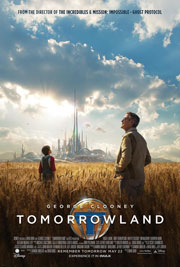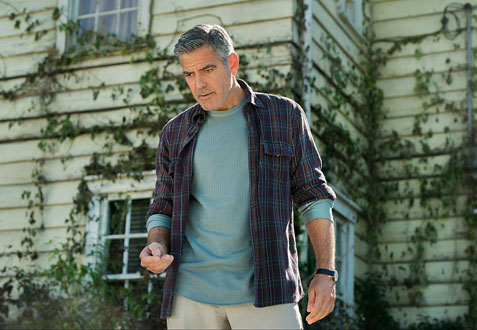
“Tomorrowland” does not play by the usual ‘Disney PG movie’ rules. It hits harder, makes the audience uncomfortable, and has an alarmingly high body count. When we finally discover the movie’s endgame, this makes perfect sense, but it might be a shock up front to parents who see that the DreamWorks Animation movies are all PG, and therefore assume that “Tomorrowland” will be no different. It is drastically different – this film is a call to arms. It may take its name from a 60-year-old section of Disney World, but this movie is as right here, right now as it gets.
And while the movie is undoubtedly better than it would have been without writer/director Brad Bird’s involvement, the fact of the matter is that this is Bird’s weakest film, but let’s put that into perspective. He directed three animated masterpieces in “The Iron Giant,” “The Incredibles” and “Ratatouille,” as well as the very good “Mission: Impossible – Ghost Protocol.” “Tomorrowland” is enjoyable; it just doesn’t measure up against Bird’s other films. It uses a jerky narrative device at the beginning that never works, and actually leaves the audience unprepared for what follows. It also has no business being 130 minutes long.
Casey Newton (Britt Robertson) is a high school science prodigy who spends her free time sabotaging the NASA site where her father (Tim McGraw, yes, that Tim McGraw) works in an attempt to delay his eventual layoff. One night she gets caught and arrested, and while retrieving her things after getting released on bail, she finds a pendant that, when she touches it, briefly transports her to another world with technology that far exceeds our own. In her quest to discover what this place is, Casey gains the help of a girl named Athena (Raffey Cassidy), who leads her to Frank Walker (George Clooney), who has also visited “Tomorrowland” but was exiled. Frank reveals to Casey that something bad is coming, and nothing can stop it. Casey convinces the jaded Frank to believe that they can avoid the inevitable, but soon they have another problem: a group of “Secret Service agents” seek to permanently close the bridge between our world and Tomorrowland, with extreme prejudice.
The two leads in a Disney movie about science and technology are girls. That is beyond cool. Sure, Clooney has the marquee headline, but that’s because his co-stars are largely unknowns, though probably not for long. Robertson bears a strong resemblance to Jennifer Lawrence, and Cassidy is a dead ringer for Emily Blunt, and both deliver solid performances. You will likely be seeing both of them on a larger stage very soon.
It would not be surprising to see certain forces launch a campaign against “Tomorrowland” in their attempt to dismiss it as leftist Hollywood propaganda, thanks to its pro-activism message. The funny thing is, Disney is practically daring people to do exactly that, because anyone who criticizes the film’s message only proves its ultimate point. One character delivers a speech that details several things that are actually happening right now, things that we need to stop right now. That isn’t propaganda – it is fact. Anyone who suggests otherwise is selling something.
Clooney does not play a convincing curmudgeon. His early scenes with Robertson are rough, lacking the anti-chemistry that reluctant partners should possess. When he starts to play something closer to the character he usually plays in films, the two start to click. Bird and co-screenwriter Damon Lindelof employ the ‘go big or go home’ rule of storytelling, and it yields some strange results. The Secret Service agents are hilarious (but for reasons we cannot explain), while a scene late in the movie climaxes with a bizarre “Da Vinci Code”-type moment. This is what makes the film so maddening; they spend so much time hiding the intentions of the enemy that when they finally get to it, you’ll wish they had gotten there 25 minutes sooner.
Think of “Tomorrowland” as Phase 2 in the Disney Human Reprogramming Project, Phase 1 being “Cinderella’s” ‘have courage, and be kind.’ This time around, the message is ‘keep dreaming, and have hope,’ with the slightly more sinister subtext: ‘if you’re not part of the solution, you’re part of the problem.’ It challenges people to step up and do something that benefits everyone, not just themselves. The very fact that that is a partisan concept these days only confirms that Bird and Lindelof are on to something here.
Related Posts
Comments Off on Movie Review: “Tomorrowland”
Posted in: Entertainment, Movie Reviews, Movies
Tags: Brad Bird, Britt Robertson, George Clooney, Tomorrowland, Tomorrowland review
















